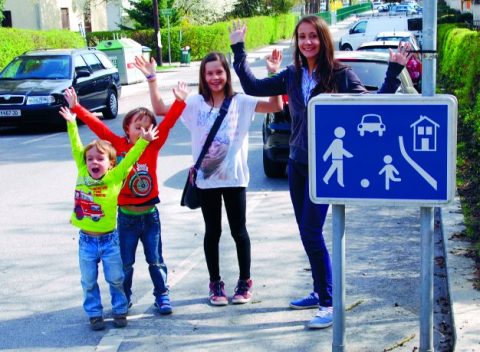Children should travel independenly – A model for child friendly tranport

Studies show that children who are not allowed to travel independently have 35% less physical agility, 40% less physical balance, 15% less creativity and 47% less autonomy and endurance during work and the number of social contacts is less than 25%.
The high volume of traffic has many negative mental and physical impacts on healthy development in infants, which for many years was underestimated. In the last decade the conditions for living and growing for children changed rapidly. The increase in motor vehicles has led not only to higher risks of child traffic accidents but also to other effects on children’s health, such as lack of physical activity, and the burden of noise and air pollution.
Motor vehicles have led to higher risks of child traffic accidents
Therefore a model shift is urgently needed in transport planning, which considers not only the built environment, but also the needs and the living environments of children. The participation of children is an important part of the required change, as well as the successful inter-sectoral collaboration between transport planners and other experts in the field of health, education, environment, planning and others.
The guidelines and regulations of child friendly traffic planning
To further help the move towards the new model in Austria, the Ministry of Environment has initiated the development of guidelines and regulations for child friendly traffic planning. These arose from a long-term working group of around 40 professionals from different sectors and included the production of corresponding guidance for the public, with sections on the special requirements of children in the public space from a pedagogical perspective, and the basic principles of child friendly transport planning.
An international initiative
International and national commitments such as the WHO Children´s Health and Environment Action Plan, the UN Convention on the Rights of a Child and EU guidelines on physical activity have each attempted to offset the impact of traffic on children; while, in Austria the climate programme – klimaaktiv mobil – and the national children’s health strategy aims to create of a child-friendly approach to traffic policy. These initiatives are finally producing results, and there are positive effects for adults as well.

Author:
Petra Volkl
Federal Ministry of Agriculture, Forestry, Environment and Water Management
Child in the City Conference Speaker
Interested in finding out more about child friendly transport planning? Join us at the Child in the City Conference in Ghent, Belgium on the 7-9 November!
More news
5 reasons why you should join the Child in the City Conference
Are you involved in education, research, urban planning or policy making? Do you advocate for children’s rights? Do you sustain a clean and friendly environment for children to play and develop? Then you are welcome to attend the 8th edition of the Child in the City Conference. The 8th edition of the Child in the City… Read more ›
How can children participate in urban planning? – Engaging children in decision making
It is not common practice to engage children into planning process. From the point of view of the researcher, however, the very fact that children are often ignored makes their perspective structurally very important. They are an intrinsic part of human society and each of them has a unique experience and a particular contribution to… Read more ›
The toolkit for developing child friendly towns and cities
A child friendly city implements children’s rights in local policy. Cities can use the translated Unicef toolkit that consists of three steps: measuring the child friendliness – perception research with children – formulating a strategy. Cities can then apply for the certification, ‘Child Friendly City’. Toolkit: assessment in three steps 1) How child friendly is… Read more ›